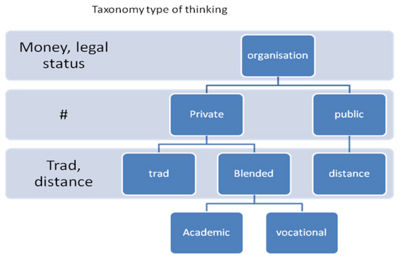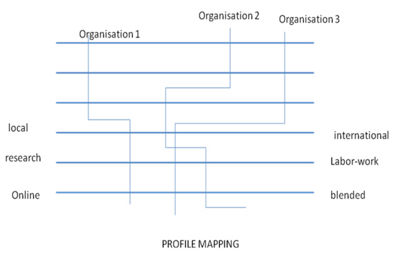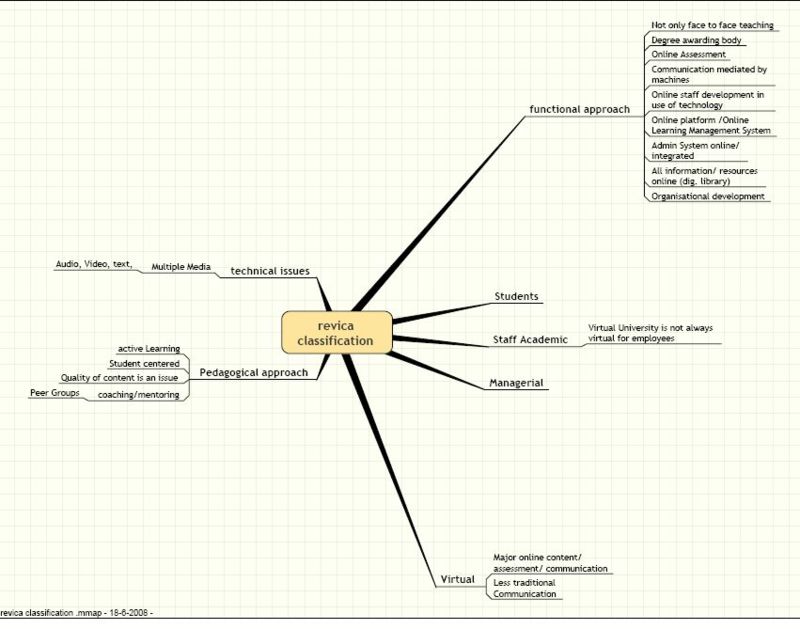Welcome to the Virtual Education Wiki ~ Open Education Wiki
Categorization
During the lifetime of the Re.ViCa project one of the outcomes will be a categorization of Virtual Campus, this is closely allied to the inventory work we are doing. We have also been calling this a taxonomy and it has already generated quite some discussion both with the partnership and also during the first key meeting in Lisbon. We therefore created this page to gather all the information on categorization/taxonomy that we have thus far arising from your own work and also systems and approaches identified both in the project writing stage and from the input provided on this topic during our first Key Meetings with the International Advisory Committee:
As listed on the Case studies page
A natural taxonomy of institutions is thus:
- Large research-led traditional university - e.g. K.U.Leuven (Belgium), University of Edinburgh (Scotland), etc
- Small research-led traditional university - e.g. University of Bangor (Wales)
- Large teaching-led new university - e.g. Middlesex University (England)
- Small teaching-led new university - e.g. Canterbury Christ Church University (England)
- Distance teaching providers (state) - e.g. Arab Open University
- Distance teaching providers (private) - e.g. Hibernia College (Ireland)
As discussed during our key meeting in Lisbon with the International Advisory Committee
Working Group 1 (notes taken by Anna-Kaarina Kairamo)
Discussed themes
- National – international different category, because of different laws
- Granularity in categorisation essential
- Some criteria which can be used are
- legal existence
- money
- single /multiple
- traditional / blended / distance, sector
- Criteria suggested are on different level or dimensions (academic single institution, vocational are organizational criteria, distance teaching is about the method)
- What is HE? What is Re.Vica framework?
- Categorisation is always subjective, prefer merely dimensions instead of categories, cases can positioned within the dimensions
- 1 Case in category problematic, 2 min so that comparison can be made
- Frame factors (context) important
- Cultural approach (different academic cultures of the disciplines) should be included in the criteria, curture and structure are intertwined
- Focus on question HOW to build virtual campus instead of searching answer for question WHAT use inductive method instead of deductive
- Instead of taxonomy profile of the VCs can be used (pict. 2 below)
Useful resource: Trainer’s and Professional’s Guide to Quality in Open and Distance Learning
Picture 1:
Picture 2:
Working Group 2 (notes taken by Theo Bastiaens)
Working Group 3 (notes taken by Ilse Op de Beeck)
The discussion that took place in group 3 on the topic of a Taxonomy revolved around the idea of plotting ‘Virtual Campus’ along the lines of certain dimensions, and then to identify where there are clusters. This can form basis on which a taxonomy can be build. It will also allow institutions to compare themselves with each other.
Here is a list of possible dimensions that could be used:
| Full academic driven (research oriented driven) | Fully labour market driven |
| Single | Partnership |
| Small scale (< 100 students) | Large scale (> 100.000 students) |
| Local | International |
| Monolingual | Multilingual |
| Fully online | Deeply blended |
| Non profit orientation | For profit orientation |
| Mono-programme (# programmes, # of subjects) | Multi-programme |
| Central decision making | Decentralised decision making |
| Highly funded | Non funded |
| Objectivist | Constructivist |
| Distribution | Cooperation |
| (who produces the programme) | |
As listed by other authors or project reports
Towards a Virtual Campus Observatory for Latin America
By Paul Bacsich, 2001 (Extract)
DIMENSIONS OF VIRTUALITY
Virtuality in a university is in my view a matter of degree, not kind. At the EdMedia workshop in Summer 1996 in Boston I proposed “five dimensions of virtuality”, and to these five I more recently added a sixth (at Online Educa 96):
- To what extent are students not physically present on campus?
- To what extent are staff used in non-conventional modes and contracts? (Part-timers, consultants, teleworkers, etc.)
- To what extent is computer and network support out-sourced?
- To what extent has physical infrastructure begun to be reduced?
- To what extent has the legal and institutional strength been reduced? (By use of devolution, consortia, ad-hoc collaborations, etc.)
- To what extent has the degree structure begun to dissolve into ever-smaller modules studied in an ever more flexible pattern?
ORGANISATIONAL MODELS
This is a fascinating subject, but one on which it is hard to get good information unless one is an “insider” to the organisation in question. The section below draws on material from the author, Robin Mason [2001] and Terry Anderson (Anderson and Downes [2000]), all of whom have significant experience working in several different organisations and advising several others
Types of Virtual University I detect three distinct abstract types of Virtual University:
- A “green fields”, that is, “new build” university which is virtual from the start. In their era, the “mega universities” (Daniel, 1996) might have been so described. More recently in the European theatre, the UK University for Industry is the best known example, provided one takes a wide enough definition of “university” since its courses are on the whole sub-degree courses oriented to industry.
- A virtual university consortium. This is where a number of universities get together in a more or less tight organisational framework to put a “skin” of virtuality around all of them. The European Commission has directly or indirectly fostered several of these, as have national funding agencies including in the UK. The UK e-University is the latest example.
- A “skin” on a conventional university (campus-based or distance learning-based), like the rind on an orange. This is what I call the Virtual Campus model – a centrally directed online learning initiative. There are at least 100 North American examples, and many more in other parts of the world including in the UK.
- Virtual Universities run by non-university organisations.
Prof. Robin Mason's Classificiation
(2001)
As an alternative viewpoint, Mason (in a paper dated 2001 but written some years previously) proposes 6 models, but admits that some blur into each other. Note that some models apply to single institutions, or almost require these, as well as to consortia.
- Brokerage – “a new organisation set up to provide courses for the life-long learning sector, but using the teaching and course resources of existing institutions”, with a “very small number of permanent staff”. Her examples: OLA (Australia), Ufi, Jones.
- Partnership – “agreements among existing universities”. Her example: OU partnerships.
- Umbrella – “existing organisations pull together… under the aegis of a slim superstructure”. Her examples include the Scottish University of Highlands and Islands (UHI) and Western Governors University in the mid-west US; but there are several more examples including UniRede in Brazil – see www.unirede.br
- Greenfield – “setting up an entirely new organisation”. Her examples include new small open universities (such as TechBC) and Magellan University.
- Network – “where existing universities and education providers collaborate in a variety of combinations” with “no central driver of the programme”. Her example is the VIRTUE project of EuroPACE.
- Dual-mode – “teaching the same courses both face-to-face and off-campus”. Her examples include University of Southern Queensland, Penn State, Wisconsin and Phoenix; but there are many many more.
BENVIC - Benchmarking of Virtual Campuses
The dimensions
A virtual campus may typologically be described in a multi-dimensional matrix, of which the dimensions are:
- The institutional basis and mission
- The scope of the offer
- The deployed activities
- The scale of the partnership
- The partnership organisation
- The audiences
- The used teaching/learning scenarios


